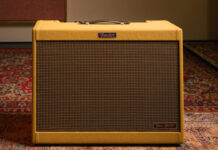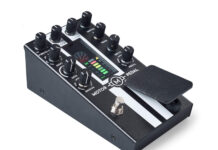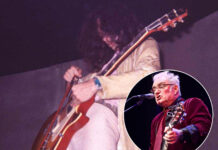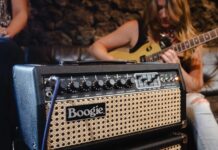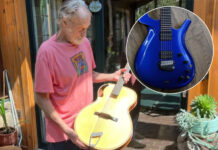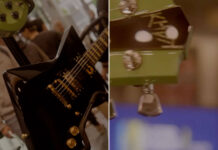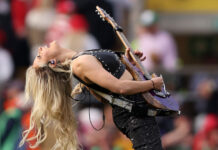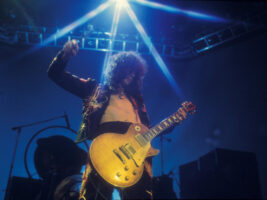
The Gear Used by Jimmy Page on Led Zeppelin’s Physical Graffiti
Physical Graffiti was Led Zeppelin’s sixth album and probably still stands as the most diverse and experimental LP. The 1975 double-album stylistically it blended middle eastern music, folk, hard rock, blues, funk, and orchestral music into something that was still cohesive and sounded like Led Zeppelin.
READ MORE: The story of Jimmy Page’s Led Zeppelin Les Pauls: four guitars that shaped Led Zeppelin
This experimental nature may have owed itself partially to the fact that the band now had its own label, Swan Song Records, which gave them much more creative control over their music than ever before. In this article, we’ll discuss the gear that Jimmy Page used to create the diverse tones we hear on the record.
Physical Graffiti was recorded over the span of just a few months, but some of the songs had been bouncing around the Led Zeppelin camp since 1970, consisting of outtakes from previous records. Others were written and recorded at Headley Grange, the same place where the band recorded their iconic fourth album.
Electric Guitars
By the time of Physical Graffiti, Jimmy Page reports that he was very much partial to his Gibson Les Paul Standards (“Number One” and “Number Two”) as the main electric guitar for most tracks. The two 1959 Les Paul Bursts were very similar and often confused, but Number Two served as more of an experimental platform for Page. Both guitars had necks that had been shaved down to a thinner profile. Page told Guitar World in 1998, “By the time of Physical Graffiti, the Les Paul was my main guitar for almost everything.”
Page received his Gibson EDS-1275 Double-Neck guitar in 1971 and found it useful in the studio for songs where a 6 and 12 string were both needed at different points in the song. This was the case on Ten Years Gone especially. There is also some speculation that a Stratocaster or Telecaster was used on Ten Years Gone, but as far as we can tell, Page’s blue Stratocaster and his Brown 1953 Telecaster with the B-Bender were purchased after the recording of that song which took place in early 1974. It doesn’t mean that a Strat or Tele were not used on the album, but at least it was not one of those two, as some online sources claim.
Page also had a 1961 Danelectro 3021 model that he used for alternative tunings and slide work such as on the cover of the classic blues song In My Time of Dying. It is also widely believed that Page used this guitar on the iconic track, Kashmir, as Page told Guitar World in the aforementioned 1998 interview, “The Danelectro was essential for open tunings.” In the live setting, Page generally relied on his “Number Two” Les Paul to perform Kashmir.
Acoustic Guitars
The album does have some acoustic tracks, which were the product of a Martin D-28 and a Harmony Sovereign H-1260. Page told Acoustic Guitar in 2010, “The Martin and Harmony were my go-to acoustics for that era.” The Martin was purchased in 1970 and outfitted with a Barcus-Berry Model 1355 Transducer pickup, paired with a Barcus-Berry Model 1330S Preamp sometime around the time of the recording of Physical Graffiti. The Harmony had also been in Page’s collection for several years prior to the recording of Physical Graffiti. We know he owned it and it was believed to be at Headley Grange during the time the album was recorded but there is no confirmation which acoustic was used on which songs.
Amplifiers
According to Page, Physical Graffiti’s sound was the result of three different amplifiers. The primary amp for electric guitar and “heavy” tones was a collection of Marshall Heads, which, as far as we know, consisted of two 1959 Super Leads and one modded Super Bass, with the Super Bass being Page’s main amp at the time and it is presumed that this was the main amp used on the album.
As for the mods on the Super Bass, that is a bit of a mystery (not an uncommon finding in the world of Jimmy Page). In a Guitar Player interview in 1977, Page claimed that Tony Franks made them “200 watts” and put “KL88” tubes in them. So, there is still some confusion on the exact nature of the mods done to his amps that we may never know. The folks at Page’s amp brand, Sundragon, made a recreation of the modified Marshalls, but when we reached out to them, they were, predictably, unwilling to share what the mods in the original were.
The clean tones and overdriven tones were often the result of a Fender Super Reverb (a 1968 model). While it’s not confirmed that the Supro Coronado 1690T that he used for all of Led Zeppelin’s first album was used on Physical Graffiti specifically, we know he still had it and would occasionally use it for “different colors” in the studio. This sort of experimentation and using different amps for different tones was almost essential given the wide range of sonic textures found on Physical Graffiti.
Effects
While Page was not a man known for outlandish use of effects, relying instead of his guitar, amp and fingers to build his tone, he did use some effects on Physical Graffiti that are worth examining. He used a Maestro Echoplex EP-3 for tape echo, and more subtly as a preamp boost. The EP-3 was the first solid state version of the Echoplex which came out in 1970. Page used a Vox V846 Wah as well. He used a Sola Sound Tone Bender Mk II for fuzz and some of the more saturated lead tones. He used an MXR Phase 90. Lastly, a violin bow, most notably on the song, In the Light.
Physical Graffiti still stands as one of Led Zeppelin’s most diverse-sounding records, and, not unlike a lot of Led Zeppelin lore, it still has some mystery regarding the gear that is used on it. As much as it pains me, as someone who tries to track down this sort of information, perhaps that’s how it should be – after all, the mystique of Led Zeppelin is as much a part of their legacy as their sound was.
The post The Gear Used by Jimmy Page on Led Zeppelin’s Physical Graffiti appeared first on Guitar.com | All Things Guitar.
Source: www.guitar-bass.net

